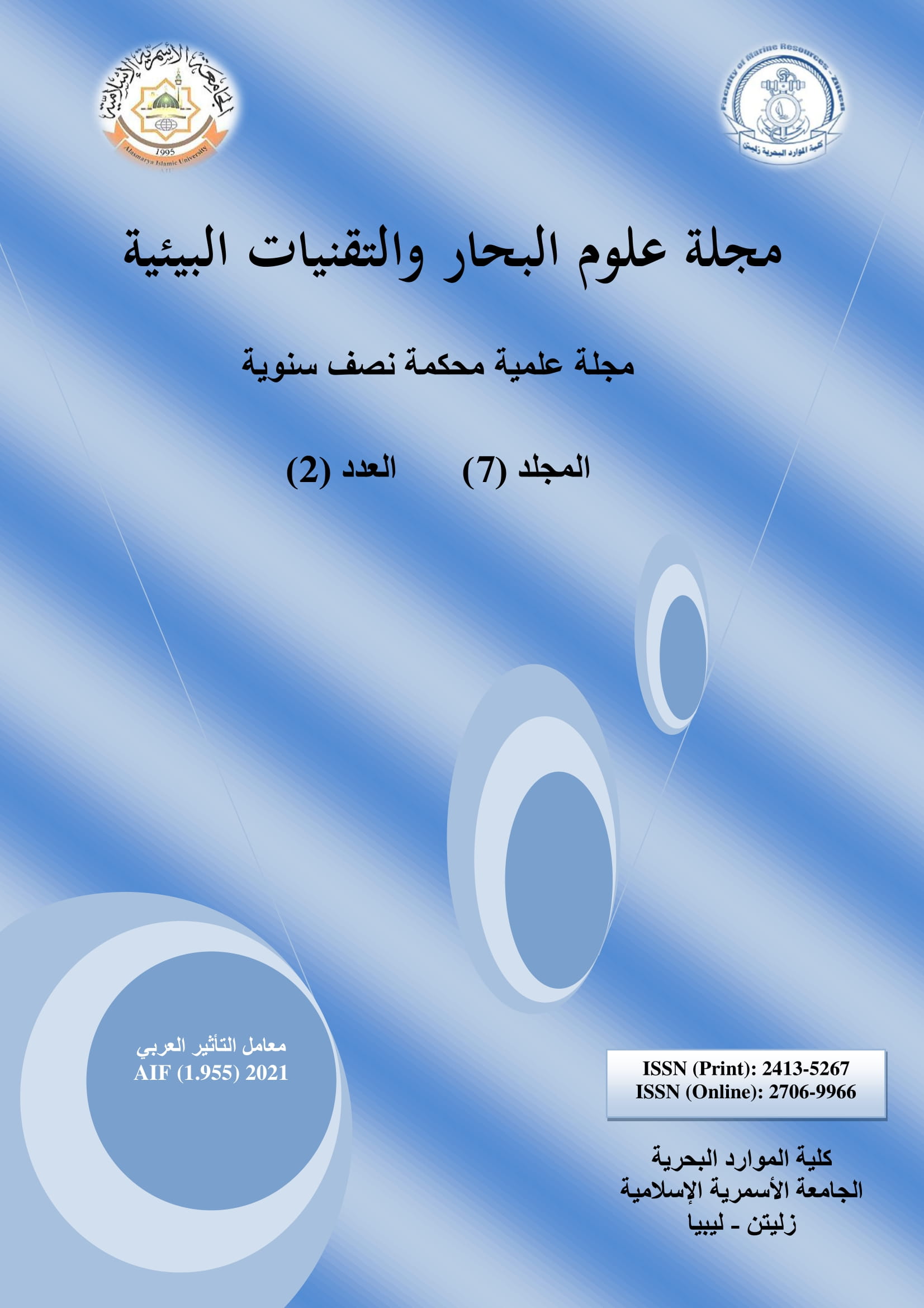تقنية المفاعلات الحيوية لمعالجة مياه الصرف باستخدام الترشيح الجذري بنباتي القصبة والسمار
DOI:
https://doi.org/10.59743/jmset.v7i2.15الكلمات المفتاحية:
مفاعل حيوي، عنصر ثقيل، القصبة، السمار، مياه الصرفالملخص
اكتسب استخدام النباتات مباشرة للحد من تلوث المياه الجوفية والسطحية اهتمام واسع بين الأوساط الأكاديمية والتطبيقية. وتعتبر النباتات المائية مثل القصبة/الغاب Phragmites australis ذات قدرة عالية على امتصاص المعادن الثقيلة مما يرفع من كفاءتها في إزالتها من المياه الملوثة على مدى عدة مواسم زراعية. حيث اظهرت النتائج وجود فرق كبير في تركيز Cuقبل المعالجة وبعدها فقد انخفض التركيز من 4.00 إلى 0.0087 مجم/لتر. كما انخفض تركيز Zn إلى 0.0868 مجم/لتر. كما انخفضت تراكيز Co و Cd من 0.400 إلى 0.043 مجم/لتر و Mn من 20 إلى 0.0219 مجم/لتر. بالإضافة إلى ذلك اظهرت النتائج أن نبات السمار Typha australis لديه القدرة على معالجة المياه الملوثة. حيث انخفضت تراكيز Cu من 4.00 إلى 0.0477 مجم/لتر، Zn من 20 إلى 0.1685 مجم/لتر. علاوة على ذلك، انخفضت تركيزات Co و Cd من 0.400 إلى 0.043 مجم/لتر و انخفض Mn من 20 إلى 0.0133 مجم/لتر. اجمالاً كانت كفاءة عامل الإزالة الحيوي للمعادن الثقيلة لنبات القصبة وفقاً للتسلسل التالي: Mn (99.89%) > Cu (99.78%) > Zn (99.65%) > Co (89.2%) > Cd (86.08%) ومن ناحية أخرى، كان تسلسل كفاءة الإزالة لنبات السمار وفقاً التالي: Mn (99.93%) > Zn (99.15%) > Cu (98.81%) > Mn (89.25%) > Cd (88.40%).
المراجع
Ahmed M.B., Zhou J.L., Ngo H.H., Guo W., Thomaidis N.S., & Xu, J. (2017). Progress in the biological and chemical treatment technologies for emerging contaminant removal from wastewater: A critical review. J. Hazard Mater., 323: 274–298.
Aishah R.M. & Elssaidi M.A. (2019). Using Pollution Indices to Assess Heavy Metals Contaminated Soil in some Libyan Regions. Libyan Journal of Ecological & Environmental Science and Technology (LJEEST), 1(1): 38-49.
Aishah R.M., Shamshuddin J., Fauziah C.I., Arifin A., & Panhwar Q.A. (2019). Using Plant Species for Phytoremediation of Highly Weathered Soils Contaminated with Zinc and Copper with Application of Sewage Sludge. Bio Resources, 14(4): 8701-8727.
Aishah R.M., Shamshuddin J., Fauziah C.I., Arifin A., & Panhwar Q.A. (2018). Adsorption-desorption characteristics of zinc and copper in oxisol and ultisol amended with sewage sludge. Journal of The Chemical Society of Pakistan, 40(5): 842-842.
Aishah R.M., Shamshuddin J., Fauziah C.I., Arifin A., & Panhwar Q.A. (2016). Phytoremediation of Copper and Zinc in Sewage Sludge Amended Soils Using Jatropha curcas and Hibiscus cannabinus. Journal of the Chemical Society of Pakistan, 38(6).
Ali N.A., Bernal M.P., & Ater M. (2002). Tolerance and bioaccumulation of copper in Phragmites australis and Zea mays. Plant and Soil, 239(1): 103-111.
Ali S., Abbas Z., Rizwan M., Zaheer I.E., Yavaş İ., Ünay A., Abdel-Daim M.M., Bin-Jumah M.,Hassanuzzman M, & Kalderis D. (2020). Application of floating aquatic plants in phytoremediation of heavy metals polluted water: A review. Sustainability, 12(5): 1927.
Bouchama K., Rouabhi R., & Djebar M. R. (2016). Behavior of Phragmites australis (CAV.) Trin. Ex Steud used in phytoremediation of wastewater contaminated by cadmium. Desalination and Water Treatment, 57(12): 5325-5330.
Chandra R. & Yadav S. (2011). Phytoremediation of Cd, Cr, Cu, Mn, Fe, Ni, Pb and Zn from aqueous solution using phragmites cummunis, typha angustifolia and cyperus esculentus. International Journal of Phytoremediation, 13(6): 580-591.
Dordio A.V., Duarte C., Barreiros M., Carvalho A.P., Pinto A.P., & da Costa C.T. (2009). Toxicity and removal efficiency of pharmaceutical metabolite clofibric acid by Typha spp.–potential use for phytoremediation. Bioresource technology, 100(3): 1156-1161.
Eid E.M., Shaltout K.H., El-Sheikh M.A., & Asaeda T. (2012). Seasonal courses of nutrients and heavy metals in water, sediment and above-and below-ground Typha domingensis biomass in Lake Burullus (Egypt): perspectives for phytoremediation. Flora-Morphology, Distribution, Functional Ecology of Plants, 207(11): 783-794.
Federation W.E., & APH Association (2005). Standard methods for the examination of water and wastewater. American Public Health Association (APHA): Washington, DC, USA.
Grisey E., Laffray X., Contoz O., Cavalli E., Mudry J., & Aleya L. (2012). The bioaccumulation performance of reeds and cattails in a constructed treatment wetland for removal of heavy metals in landfill leachate treatment (Etueffont, France). Water, Air, & Soil Pollution, 223(4): 1723-1741.
Hoagland D.R. & Arnon D.I. (1941). Physiological aspects of availability of nutrients for plant growth. Soil Science, 51(6): 431-444.
Mal T.K. & Narine L. (2004). The biology of Canadian weeds. 129. Phragmites australis (Cav.) Trin. ex Steud. Canadian Journal of Plant Science, 84(1): 365-396.
Mustafa G., Tahir H., Sultan M., & Akhtar N. (2013). Synthesis and characterization of cupric oxide (CuO) nanoparticles and their application for the removal of dyes. African Journal of Biotechnology, 12(47): 6650-6660.
Peltier E.F., Webb S.M., & Gaillard J.F. (2003). Zinc and lead sequestration in an impacted wetland system. Advances in Environmental Research, 8(1): 103-112.
Qdais H.A. & Moussa H. (2004). Removal of heavy metals from wastewater by membrane processes: a comparative study. Desalination, 164(2): 105-110.
Reeves R.D., Baker A.J., Jaffré T., Erskine P.D., Echevarria G., & van der Ent A. (2018). A global database for plants that hyperaccumulate metal and metalloid trace elements. New Phytologist, 218(2): 407-411.
Rzymski P., Niedzielski P., Klimaszyk P., & Poniedziałek B. (2014). Bioaccumulation of selected metals in bivalves (Unionidae) and Phragmites australis inhabiting a municipal water reservoir. Environmental monitoring and assessment, 186(5): 3199-3212.
Srivastava M., Ma L.Q., Singh N., & Singh S. (2005). Antioxidant responses of hyper-accumulator and sensitive fern species to arsenic. Journal of Experimental Botany, 56(415): 1335-1342.
Volesky B. (2000). Detoxification of metal-bearing effluents: biosorption for the next century. Hydrometallurgy, 59: 203–216.
Windham L., Weis J.S., & Weis P. (2001). Patterns and processes of mercury release from leaves of two dominant salt marsh macrophytes Phragmites australis and Spartina alterniflora. Estuaries, 24(6A):787–795.
التنزيلات
منشور
إصدار
القسم
الرخصة
الحقوق الفكرية (c) 2021 مجلة علوم البحار والتقنيات البيئية

هذا العمل مرخص بموجب Creative Commons Attribution 4.0 International License.









